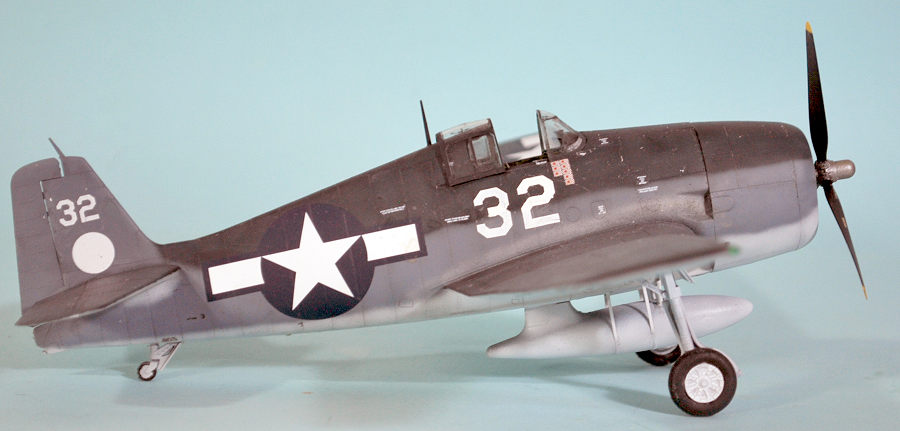
Eduard 1/48 F6F-3 Hellcat
| KIT #: | 8227 |
| PRICE: | $49.95 |
| DECALS: | Five options |
| REVIEWER: | Tom Cleaver |
| NOTES: | Re-release; Eduard resin wheel wells and Bitskrieg prop used. Profipack. |

| HISTORY |
Spider Webb over Guam:
June 19, 1944, saw the biggest air battle of the Pacific War, known to history as “The Marianas Turkey Shoot,” Over the course of the day, beginning at 0715 hours, 350 Imperial Navy aircraft would be shot down by the Hellcats defending the invasion force; the battle would end Japanese naval air power.
After the first wave of attackers were shot down, strikes were launched against the airfields on Guam the survivors would head for. Aboard USS Hornet (CV-12), Air Group Two was ordered to participate in the first of these strikes at 1030 hours, to hit the airfield on Marpi Point.
Among the VF-2 pilots assigned s was Ensign Wilbur B. “Spider” Webb, who had earned his Wings of Gold as an enlisted Naval Aviation Pilot First Class in July 1943, commissioned an Ensign shortly thereafter.
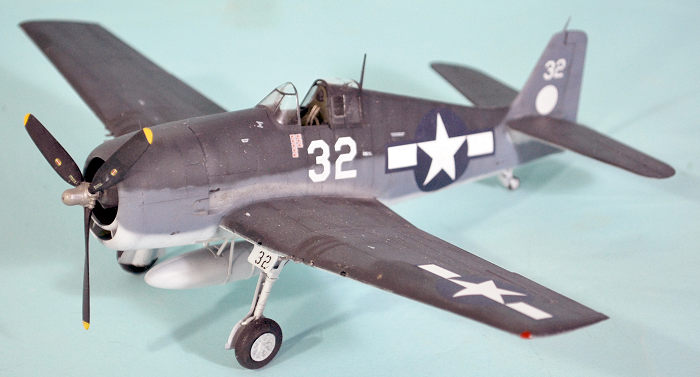 The
first strike failed to spot enemy aircraft. At 1300 hours, a call was made for
volunteers to fly a mission against anti-aircraft positions on Guam. Though he
had already flown two missions, Webb was ready for more. His division leader,
Lt(jg) Tex Vineyard, decided not to fly again and Webb was assigned as wingman
for Lt(jg) Conrad Elliott; they were the flight's tail-end Charlie.
The
first strike failed to spot enemy aircraft. At 1300 hours, a call was made for
volunteers to fly a mission against anti-aircraft positions on Guam. Though he
had already flown two missions, Webb was ready for more. His division leader,
Lt(jg) Tex Vineyard, decided not to fly again and Webb was assigned as wingman
for Lt(jg) Conrad Elliott; they were the flight's tail-end Charlie.
Webb departed Hornet at 1430, for once flying his assigned F6F-3, an event that almost never happened. Over the target, his division remained as high cover for the torpedo planes and dive-bombers before strafing their assigned targets. Once completed, the strike force joined up just off Orote Peninsula. Minutes later, he spotted an American pilot in a rubber life raft. He radioed his discovery and CAG Jackson Arnold ordere him to cover the pilot while Elliott rounded up one of the OS2U Kingfishers assigned for rescue duty.
As he orbited the pilot at 100 feet, he spotted a long line of airplanes apparently headed for the airfields on the northern end of the island. “My first thought was, why are our airplanes flying along there with their landing gear down?”
Webb quickly became aware of his mistaken identification of the aircraft. “The first planes were heading for me, and they got to within less than a hundred yards of me before I realized they were Japanese Val dive-bombers, with fixed landing gear. When they reached the landing pattern for the field, they banked away, and I could see the large red meatballs on their sides. I estimated that there were 30-40 planes in all. I thought, ‘Boy, this is it. Make it good and get as many as you can before they know you’re here!’” He turned toward the enemy. “I had not been detected so far, so I decided not to gain altitude, but to just slide into their traffic pattern and get as many as I could before I was detected.”
As he closed on the Vals, he radioed, "Any American fighter, I have forty Jap planes surrounded at Orote Airfield. I need some help! Hey Rube!"
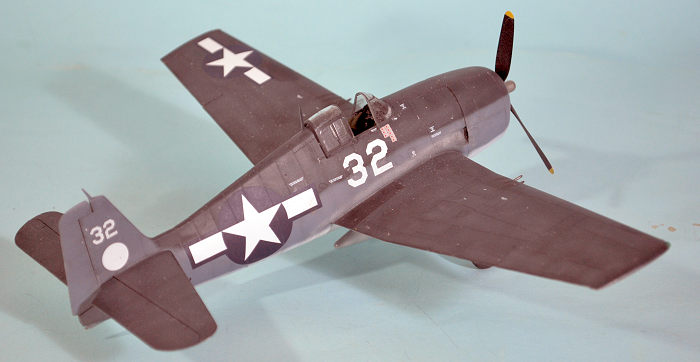 Webb
swung in behind the first plane and squeezed the trigger. The Val exploded
instantly. Webb eased over to the middle plane and fired again. That Val's
vertical stabilizer disintegrated as the starboard wing of the aircraft came off
and the plane exploded. “By the time I eased in behind the third plane, my speed
had built up and I started overrunning it. The rear-seat gunner was firing
directly at me, but he did not hit my aircraft. I was holding down the trigger,
but this plane did not seem to want to burn. I kept saying, ‘Burn, you bastard,’
over and over until it finally did explode. If it had not exploded, I would have
collided with it, I guess. When it did explode, I flew through the explosion and
sustained several holes in my F6F.”
Webb
swung in behind the first plane and squeezed the trigger. The Val exploded
instantly. Webb eased over to the middle plane and fired again. That Val's
vertical stabilizer disintegrated as the starboard wing of the aircraft came off
and the plane exploded. “By the time I eased in behind the third plane, my speed
had built up and I started overrunning it. The rear-seat gunner was firing
directly at me, but he did not hit my aircraft. I was holding down the trigger,
but this plane did not seem to want to burn. I kept saying, ‘Burn, you bastard,’
over and over until it finally did explode. If it had not exploded, I would have
collided with it, I guess. When it did explode, I flew through the explosion and
sustained several holes in my F6F.”
After downing the first three, Webb slipped in behind another group of three and again started by firing on the plane on the left. “The rear-seat gunner of this aircraft was firing directly at me from no farther than 30 yards. I could see the colors of his flight suit, helmet, and skin. Then he seemed to kind of give up. He put his hands up before his face - maybe he thought I was going to run into him - just before several slugs hit him in the chest and face. The pilot bailed out over the side. We were at no more than 200 feet, so I doubt if he made it.’
The lead Val got away but Webb managed to hit the other wingman on the right. “When I fired, it started shedding pieces and smoking badly. Then his tail disintegrated, and he just fell.”
Heavy flak was coming up from Orote Peninsula. “I could see tracers continually coming up in front of me. I guess they had never seen an F6F Hellcat flying so slow. At the time, I did not realize that my plane had been hit.”
By this point, planes were all over the sky. Several other Hellcats had arrived. “No matter where I looked, I could see either a parachute or a burning plane. It seemed like a mad flying circus, only this was real.”
After his fifth Val, Webb’s guns stopped firing. Pulling out, he pushed the gun chargers until he got one gun in each wing working, then headed back into the fight. “Almost immediately, I saw a Val coming toward me from above. It was at about 1,000 feet. I got it in my sights and squeezed the trigger. As my guns fired, a third gun started working. This Val seemed to explode in half just behind the pilot, who bailed out.”
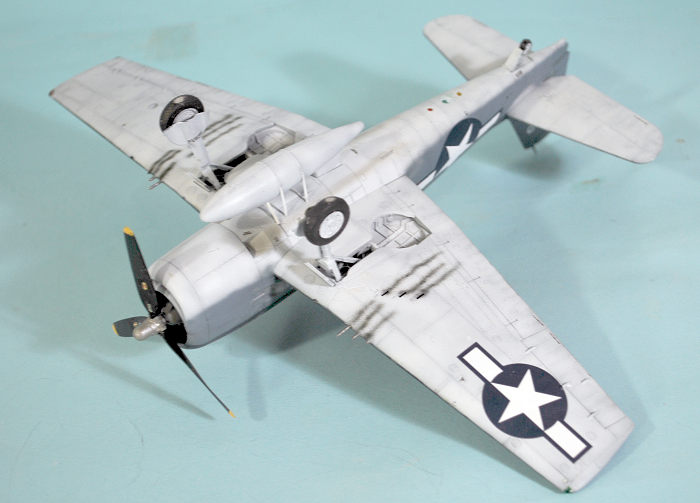 His
guns quit again. He managed to get two on the right wing and one in the left
working and headed back into the fight. “I saw another Val low on the water, so
I started firing. I killed the rear-seat man, and the plane started smoking. We
were heading toward the cliff edge of Orote Peninsula. I had to pull up to avoid
the cliff, so I did not see whether this plane crashed or not.”
His
guns quit again. He managed to get two on the right wing and one in the left
working and headed back into the fight. “I saw another Val low on the water, so
I started firing. I killed the rear-seat man, and the plane started smoking. We
were heading toward the cliff edge of Orote Peninsula. I had to pull up to avoid
the cliff, so I did not see whether this plane crashed or not.”
His guns quit a third time, forcing him to turn out of the fight until he managed to get one working. “At that moment, I spotted one of our Hellcats, with a Zero on its tail. The Hellcat was in a bad way. I had only one gun working, but I managed to shoot a few pieces off the Zero and run him off of the Hellcat, which, it turned out was flown by Lieutenant (jg) Bill Levering, a night-fighter pilot from my ship.”
Webb stayed in the fight. “I fired at many more Vals and Zeros. I knocked pieces from some and caused others to burn, but none was seen to crash. When all my guns became permanently inoperative, I headed out of the fight and toward the open sea.”
Webb then realized his canopy was shot up and there were several holes in the wings. “My goggles were gone, my radio was out, the cylinder-head temperature was high, and oil was all over my cowling and windshield. I found out later that there were over 100 holes in my aircraft. I was beginning to wonder how I was going to get back to my carrier when a Fighting Two Hellcat joined up on me. I quickly gave him the lead and, by hand code, told him to lead me home. The pilot was Ensign Jack Vaughan, and I was never happier to see anyone than I was to see him at that time.”
By the time Webb trapped back aboard Hornet, Elliott had already returned and made his official report. “My gun-camera pictures confirmed four of my victories before the camera jammed. For this action, I was recommended for the Congressional Medal of Honor by Admiral Mitscher, but I was awarded the Navy Cross.” Webb was credited with six Valls destroyed and two probables.
| THE KIT |
Eduard first released their Hellcat kit in 2007, with releases as both F6F-3 and F6F-5, with limited-release night fighters and a release of the kit in Fleet Air Arm markings. This is a re-release of the F6F-3 with new decals. The primary physical difference is this kit is molded in grey plastic rather than the tan plastic of the first release.
| CONSTRUCTION |
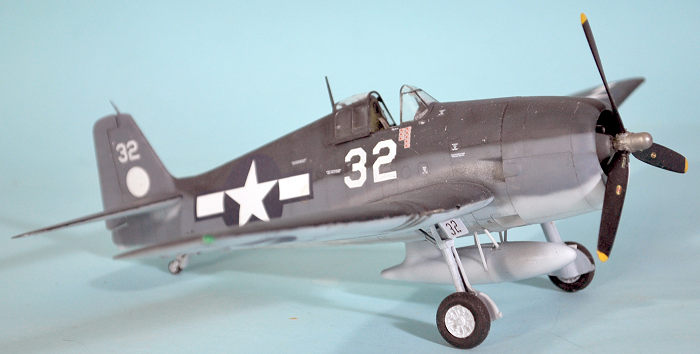 Two
complaints about the Eduard Hellcats has been the shallow wheel wells lacking
all detail, and an incorrect prop. Eduard has released 3D printed wheel wells
that are fully detailed to coincide with this release. I replaced the prop with
a correct one from Bitskrieg, a Ukrainian aftermarket company.
Two
complaints about the Eduard Hellcats has been the shallow wheel wells lacking
all detail, and an incorrect prop. Eduard has released 3D printed wheel wells
that are fully detailed to coincide with this release. I replaced the prop with
a correct one from Bitskrieg, a Ukrainian aftermarket company.
I removed the molded-in wheel wells from the lower wing parts and replaced them with the resin wheel wells, which were a drop-fit replacement. Eduard also now has 3D decals for the instrument panels in the cockpit, which also are a vast improvement over the 2D photoetch set. Other than that, the model was assembled as the previous Eduard Hellcats, without difficulty.
| COLORS & MARKINGS |
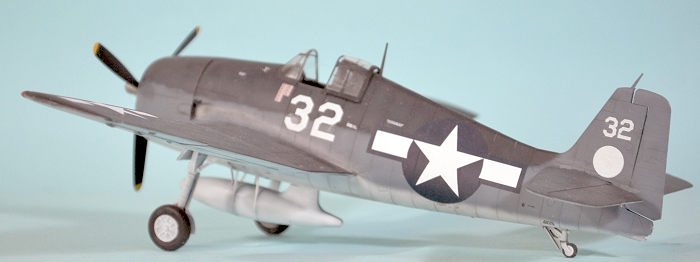 I used Gunze
Sangyo paints for this project. I used Mr. Color C-366 “Intermediate Blue” and
H-365 “Sea Blue” for the upper colors and Mr. Hobby Acqueous H-21 “Off-White”
for the tricolor scheme.
I used Gunze
Sangyo paints for this project. I used Mr. Color C-366 “Intermediate Blue” and
H-365 “Sea Blue” for the upper colors and Mr. Hobby Acqueous H-21 “Off-White”
for the tricolor scheme.
I used the kit decals for the national insignia and stencils, and pieced together the individual aircraft numbers from a letters-and-numbers sheet in the decal dungeon.
I lightly weathered the model, then attached the canopy in the open position at attached the prop.
| CONCLUSIONS |
There is no really correct Hellcat kit available in 1/48, but the Eduard kit is the best of those available. It is not difficult to create a nice model from what’s in the box for any modeler with a modicum of experience. Recommended for naval aircraft fans.
17 August 2023 Copyright ModelingMadness.com. All rights reserved. No
reproduction in part or in whole without express permission.
mailto:svanaken61@gmail.comIf you would like your product reviewed fairly and
fairly quickly, please
contact
the editor or see other details in the
Note to
Contributors.